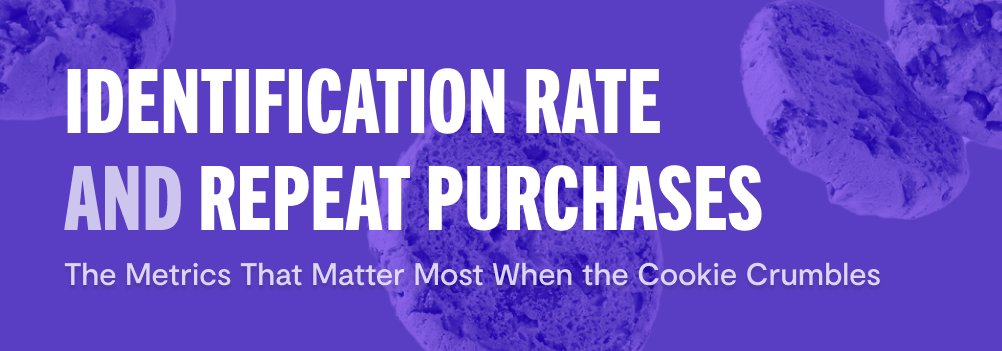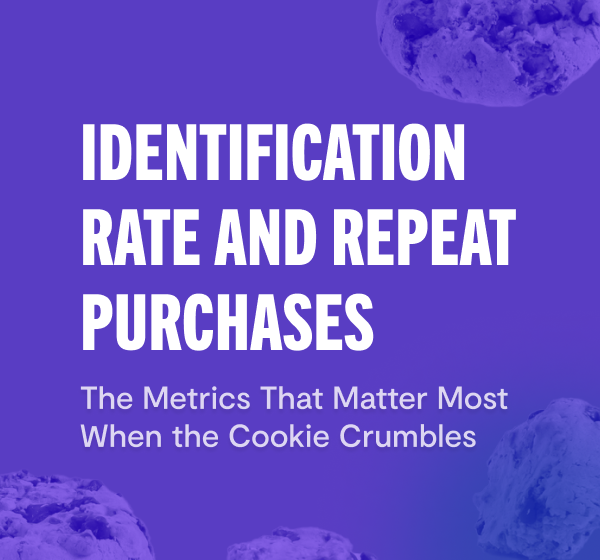

Identification Rate and Repeat Purchases: The Metrics That Matter Most When the Cookie Crumbles
Google is officially sticking with one of its 2024 New Year’s resolutions: phasing out third-party cookies. On January 4, Google began restricting access to cookies, limiting cross-site tracking for 1% of Chrome users. Third-party cookies are the most cost-effective way to reach new customers, which means a massive impact on retailers.
While cookies have been eroding for years, many retailers still rely heavily on them for targeting, personalization, log-in, and managing tags on the website which relay information to key partners and systems. Without cookies, there will be smaller reach. Cost per click and cost per mille — and ultimately, customer acquisition costs — will increase as a result.
Because acquisition and retargeting fuel retention, retailers must find effective alternatives — fast.
The most important metrics in a post-cookie world
While 1% doesn’t sound like many, that number represents 30 million Chrome users all over the world. And of course, 1% will eventually become 100%.
Starting now, all retail leaders must focus on two critical metrics: repeat purchase and identification rates.
Repeat purchase rate
The drop in reach may not be immediately visible, but retailers must monitor key performance and customer data weekly to understand how to respond. Think of the cost of customer acquisition. There will be a revenue impact, especially as Google ups the percentage of Chrome users who can’t be tracked with third-party cookies.
Paid channel ROI will only continue to decrease, especially once major players like Google and Facebook launch their own tracking and measurement solutions. Shifting to customer spend metrics like repeat purchase rate will put in perspective how much a retailer is spending vs. how much they earn per shopper on search.
Repeat purchasers are far more valuable to retailers than new customers. Bluecore found that second-time buyers are 101% more valuable than first-time buyers. With each subsequent purchase, the likelihood that someone will buy again only increases.
Identification rate
Retailers have traditionally focused on identity resolution, or having a single view of a customer based on multiple profiles from multiple technologies. Instead, they should focus on identity recognition, which is measured by identification rate.
Identification rate is defined as the percentage of website shoppers who can be “identified” by an attribute — a phone number or email address, for example — tied back to a unified profile. And it’s crucial as it’s the lifeblood of a retailer’s acquisition and retention strategies.
However, this metric remains elusive for many retailers. Just 21% of shoppers were identified on Black Friday, for example. For retailers reliant on third-party cookies, that number will erode considerably more.
By understanding who is visiting your websites — not just who’s logged in — you can better understand how robust your customer data file is. To maintain reach and relevance, you must build out an identification strategy for a post-cookie world.
Reviewing your first-party identity recognition strategy
Another common misconception about identification rate is that it’s something retailers have to measure once. Meanwhile, it fluctuates constantly, depending on who’s visiting a website.
Transparency gives you the ability to know your identification rate on any given day — and what’s influencing it. With better identification rates, you can maintain reach and relevance, which are a byproduct of data hygiene and completeness, capture strategies, network strength, and visibility into reporting.
Without improving identification rates, what’s historically been considered a marketing problem will quickly become an enterprise-wide fire.
To review your first-party identity recognition strategy, retailers should ask themselves the following questions:
- First, do you have visibility into your current identification rate? And what contributes to it?
- Have you invested in a first-party identity network to improve identity recognition rate in a privacy-compliant manner?
- Think of the sources that generate shoppers who self-identify and become retained customers. Is your acquisition team maximizing those sources versus general traffic?
- How is identification data being put to work to improve reach across all digital and physical channels?
- What tests have you run over the past 12 months — and plan to run over the next two quarters — to increase your identification rate?
- Is the data you have across your customer file as robust as what you have on your top customers? Or is your CDP missing signal beyond transactional data to create incremental value out of one-time buyers?
How Bluecore can help
Every retailer using a CDP must map the points of integration unnecessary to be fully reliant on first-party data. Luckily, Google’s depreciation of third-party cookies isn’t a surprise. The announcement was initially made nearly three years ago, giving us plenty of time to prepare.
Bluecore has always focused on first-party cookies and identification in anticipation of this by major portals and networks. Our combination of first-party data and direct high match rates helps preserve reach for our customers.
With more than 900 million email addresses and 10 billion daily events, the Bluecore Transparent ID Network allows retailers to identify anonymous shoppers, increasing their identification rates within 24 hours. Identification rate is the leading indicator of Customer Movement, or a retailer’s ability to move browsers to buyers, first-time shoppers to repeat customers, and repeat customers to loyalists.
We have worked with some of the largest retailers in the world to audit and close gaps in their first-party identification strategies. Using our proprietary Customer Movement Table, we compare retailers with their industry peers.
That allows them to understand the gaps to decrease customer acquisition costs, measure channel performance, and ultimately drive profitable growth.If your brand wants to understand how to monitor and increase identification rates, as well as identify strategies for growing repeat purchase rates, contact us for a free Customer Movement assessment.





